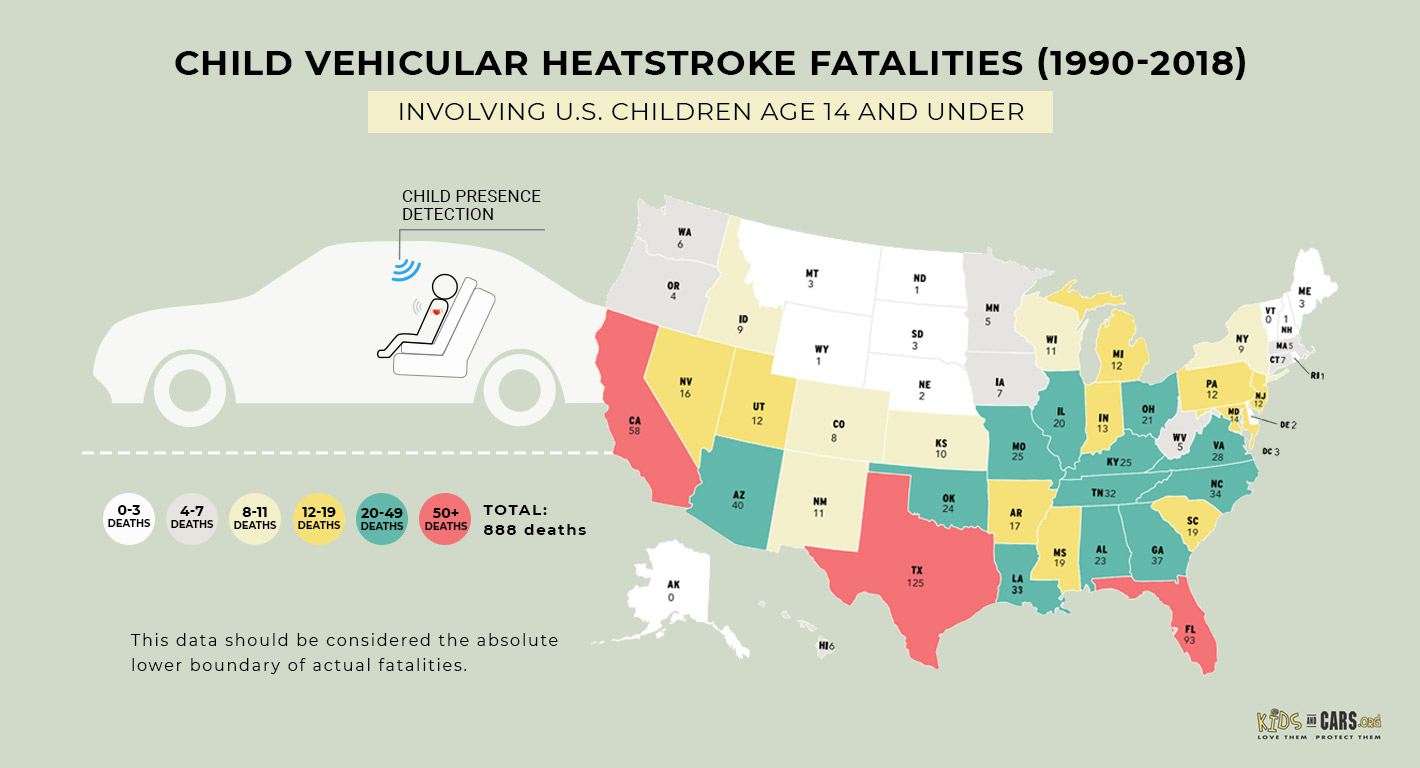Vehicular heat stroke deaths
On average, 38 children in the US die annually from heatstroke after being left in a hot car. Last year this number peaked at a heartbreaking 52.

Image adapted from www.kidsandcars.org
But how could this happen?
Human body temperature is regulated within a narrow range of several degrees around 37°C (98.6°F). Once it rises to 42°C (107.6°F) and above, cytotoxicity occurs. Proteins start losing the high-level structure important for their proper function and DNA synthesis is impaired, which eventually results in organ failure and neuronal impairment.[1]
The most effective means of thermoregulation in humans is sweating. Sweat glands release water to the skin surface, where it quickly evaporates, subsequently cooling the skin and blood beneath. This happens mostly through eccrine glands which excrete salt-and-water based liquid into ducts that open on the skin surface. There are also apocrine glands, but they are attached to hair follicles and secrete an oily substance. [2] Apocrine sweat glands in humans start to function at puberty under the stimulation of sex hormones. [3] In animals, apocrine glands are the predominant type, and human is the only mammal that has eccrine glands over most of their body surface. It is this evolution to eccrine gland-dominant skin that is one of the most important traits that allowed humans to gain a survival advantage against the extremes of climate variations. [2]
However, children and especially newborns are not so good at thermoregulation. Their core temperature is higher than that of an adult, and though they are sweat glands that exist at birth, they are not yet fully functional. Newborns sweat primarily from their foreheads, while preterm babies may completely lack a sweat response to heat. [4] Older infants do sweat, but this puts them at risk of dehydration. Babies have a larger body surface area relative to their body weight and they are more metabolically active, so they generate more heat. There is a higher rate of exchange between children’s bodies and their environment than that of an adult, as their larger surface areas allow for faster acquisition of outside temperature conditions [5]. All this makes body temperatures of children rise at a much higher rate – three to five times faster than it happens in adults.
A car is like a greenhouse. It allows the interior temperature to rise on a sunny day way above the temperature of the air outside. And it happens quickly – the steepest temperature rise in a car occurs in the first 15 to 30 minutes. Leaving the windows slightly open unfortunately does not help [6], nor does parking in the shade. It turns out vehicular heatstroke can occur even when outside temperatures are as low as 14°C (57°F)
It is easy to think: I could never leave a child unattended in a car, I’m not that irresponsible!
But the fact is mistakes happen to the best of us. Being under prolonged stress or sleep deprivation can easily make us forgetful and less alert. So could an abrupt change in routine – you are used to your partner taking the kids to the kindergarten, but today the task was assigned to you. You get an uncomfortable call, and preoccupied with thoughts about it, you just go to work, leaving the child behind – and your life is never the same again.
Some people leave the child in a car knowingly, thinking: I’ll be back in a couple of minutes, why should I wake them from their sleep. But unpredictable things happen.
One might not even be aware that their child has crawled into the car playing hide and seek, and fell asleep.
We need less blaming and shaming, and more automated detection mechanisms to help us complement our imperfect nature.
With the advancement of computer vision, video cameras can be used successfully to detect unattended children in vehicles and send an alert about it. The downside is that cameras might make you feel like your privacy is invaded. But there are other less threatening options, such as infrared sensors, ultrasound sensors and radars. Radars are a good choice because of their insensitivity to lighting, working equally well in light as in the dark; their low price, small size and integrability (NoraSens solution). They can track millimeter and sub-millimeter displacements of the chest due to breathing and heartbeat through the slight change in the emitted electromagnetic waves as they bounce off of a person, and can thus also be used to assess a child’s vital signs [7].
Starting 2022, the European New Car Assessment Programme (Euro NCAP), a car safety performance assessment programme, will begin awarding points to cars that offer a system of child presence detection. While there is some debate in the US whether in-vehicle child sensing technology should be mandatory and regulated by law, there is no doubt that we can benefit from it in the most critical situations.
[5] Sanders, Sophia. “Thermoregulation in Humans: A Review of Developmental Changes.” (2016).
